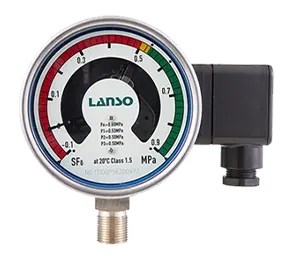SF6 relay plays a crucial role in SF6 circuit breaker, monitoring gas pressure changes to ensure the circuit breaker operates correctly. In this article, we delve into the basic principles of SF6 relay, discussing two common types of SF6 relays for SF6 circuit breakers, as well as their advantages and disadvantages.
Basic principles of SF6 relay
An SF6 relay is connected to the braking gas chamber inside the SF6 circuit breaker, monitoring changes in SF6 gas pressure. When the SF6 gas pressure drops to the first alarm value, the density relay sends a data signal to warn of low pressure. When the SF6 gas pressure drops to the second alarm value, the density relay transmits a lockout pressure data signal, simultaneously cutting off the power switch tripping control circuit to achieve a lock-out.
The SF6 circuit breaker uses SF6 gas as the insulating material and arc-extinguishing material. Under 150℃, SF6 gas has excellent organic chemical plasticity, not reacting chemically with common metal materials, plastics, and other raw materials in circuit breakers. At one atmospheric pressure, the volume resistivity of SF6 gas is two to three times that of the gas. The volume resistivity of SF6 gas increases with increasing pressure. When SF6 gas pressure is three atmospheric pressures, SF6 gas can achieve or exceed the volume resistivity of common transformer oil. However, because the pressure of SF6 gas changes with changes in working temperature, we use the SF6 relay to detect whether the SF6 circuit breaker gas is leaking, thereby completing the low pressure alarm and lockout function. Currently, there are two common types of gas density relays on the market, one is a built-in gas density relay with compensation, and the other is a relative cavity gas density relay.
Compensated built-in SF6 relay
The compensated built-in SF6 relay contains a Bourdon tube used to measure the internal gas pressure of an SF6 circuit breaker. Under constant volume, the pressure of SF6 gas at a certain temperature can represent the density of SF6 gas, typically using the pressure of SF6 gas at 20℃ as the density index value. Changes in pressure caused by temperature changes are compensated through the compensation piece between the pressure element and the moving component to ensure accuracy of density indication.
Relative cavity SF6 relay
The relative cavity gas density relay chiefly consists of bellows, standard SF6 gas, micro-motion contact point switch, shaft, and lever. Specifically, C1-L1 serves as an electrical contact point for alarms when the SF6 gas reduces, while C2-L2 serves as an electrical contact point to lock the circuit breaker when the SF6 gas reduces. The main principle of the relative cavity SF6 relay is to exploit the relationship between SF6 gas density and pressure and calculate gas density by measuring gas pressure. When SF6 gas density changes, the pressure inside the relay will correspondingly change, triggering an alarm or control circuit, alerting the operator to address it timely.
In the electrical power system, SF6 gas, due to its excellent insulating and arc-quenching capabilities, is widely used as an insulating medium for high-voltage switch cabinets, transformers, and other equipment. Therefore, monitoring SF6 gas density is of paramount importance to ensure safe operation of electric power equipment. The Relative cavity gas density relay, as a commonly used monitoring device, can promptly detect abnormal changes in gas density, effectively preventing equipment faults.
Through a detailed understanding of these two types of SF6 relays' basic structure, we can better choose and maintain the density relay suitable for SF6 circuit breakers, ensuring efficient operation of equipment under complex and sudden conditions. These relays play a critical role in ensuring the stability of equipment in the power system.
Related Article for Reference
Application Advantages of SF6 Relay Three-way Valve
Due to power outages and difficulties in disassembly, the operating SF6 gas density relay may exhibit phenomena such as inflexible action and poor contact, which can easily lead to false operation of ...
Sat 08 2023
Inspection and Usage of SF6 Gas Density Monitor
Sulfur Hexafluoride (SF6) gas, as a key insulating and arc extinguishing medium in power systems, plays a crucial role in ensuring the stability and insulation performance of equipment for normal oper...
Tue 04 2024







